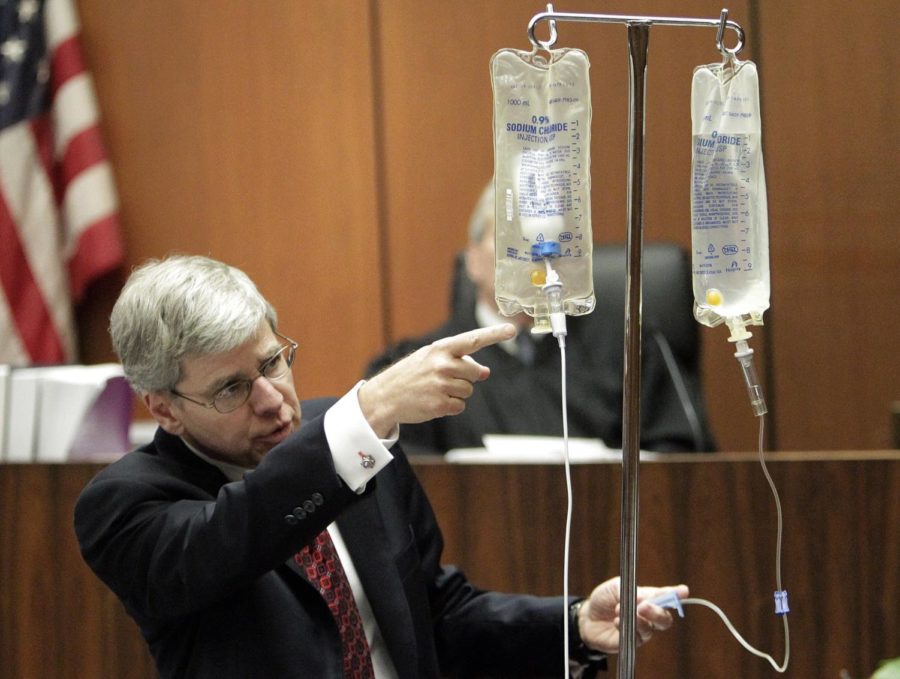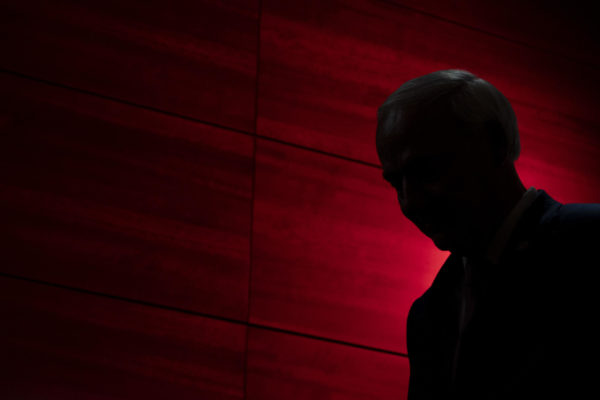Prosecutor grills key defense expert in Conrad Murray trial
Anesthesiology expert Dr. Steven Shafer, left, demonstrates the use of propofol after placing a propofol bottle in an empty saline bag during Dr. Conrad Murray’s involuntary manslaughter trial in Los Angeles on Thursday, Oct. 20, 2011. Murray has pleaded not guilty and faces four years in prison and the loss of his medical license if convicted of involuntary manslaughter in Michael Jackson’s death.
October 31, 2011
The anesthesiologist hired by Dr. Conrad Murray’s lawyers testified Monday that “no amount of money” could get him to take the job of giving Michael Jackson the surgical anesthetic propofol in his bedroom to help him sleep every night.
“Absolutely not,” Dr. Paul White testified. “That would be a job I would never consider accepting.”
Jackson family matriarch Katherine Jackson canceled plans to fly to London this week for the premiere of a documentary about her late son so that she would not miss a verdict, her assistant told CNN. She will return to court Tuesday, he said.
Closing arguments could come Friday or next Monday, depending on how much time prosecutors take for their rebuttal case and how much time lawyers are given to prepare, according to sources close to the defense.
Michael Jackson’s father Joe Jackson and sister La Toya Jackson were joined by Kathy Hilton — a longtime friend of Michael Jackson and Paris Hilton’s mother — in the seats set aside for Jackson family Monday.
Dr. White, who testified last week that Jackson probably died from drugs he gave himself, faced tough cross-examination Monday by Los Angeles County Deputy District Attorney David Walgren in Murray’s involuntary manslaughter trial.
The prosecution contends that Murray’s reckless use of propofol to put Jackson to sleep caused Jackson’s death, but the defense blames Jackson for self-administering the fatal overdose while Murray was not watching.
The exchanges between the prosecutor and defense expert became so heated at one point the judge sent jurors from the courtroom while he mediated a dispute.
Los Angeles County Superior Court Judge Michael Pastor warned White to avoid references to his personal conversations with Murray, which could have been a way for the defense to introduce statements from the defendant without him having to testify.
“Nice try,” Judge Pastor said to defense lawyer Michael Flanagan. “This is so obvious.”
The Los Angeles County coroner ruled that Jackson’s June 25, 2009, death was caused by “acute propofol intoxication” in combination with two sedatives.
Jurors must choose between two competing theories offered by White and Dr. Steven Shafer, the prosecution’s anesthesiologist, of how and when the fatal overdose entered Jackson’s body.
Both doctors, longtime friends and colleagues, are among the top experts in the world concerning propofol.
White, in his testimony for the defense Friday, said the level of drugs found in Jackson’s stomach, blood and urine, convinced him that the pop icon died after he rapidly injected himself with propofol on top of a large dose of lorazepam he swallowed when Murray was away.
Shafer, who testified over an 11-day span for the prosecution, concluded the “only scenario” that fits the scientific evidence is that Jackson was on a constant IV drip of propofol for three hours before his death.
Shafer testified that Murray must have also injected Jackson with a series of large doses of lorazepam, a sedative, hours before his death.
The prosecution theory requires “an incredible coincidence of circumstances” using a “befuddling” IV drip configuration and an “irrational” assumption about how Murray injected sedatives, White testified.
White testified Friday that it is his opinion Jackson died after he injected himself with a 25-milligram dose of propofol between 11:30 a.m. and noon. Testimony and phone records indicated it was about noon that Murray realized Jackson was not breathing.
White theorized that Jackson could have “pushed” the drug into an catheter in his leg using a syringe over a 15- to 30-second period, much faster than a doctor would have done.
“I believe it could potentially have lethal consequences,” White testified.
Under cross-examination Monday, White theorized that Jackson used a syringe used by Murray when he gave Jackson a 25-milligram injection an hour earlier. Murray filled it with 50-milligrams initially, leaving it half-filled in Jackson’s bedroom, under White’s theory.
White said he ruled out the possibility that Murray would have injected the fatal dose unless “he wanted to potentially harm Mr. Jackson.”
Walgren asked White if he thought Jackson intended to harm himself.
“I don’t think he realized the potential danger,” White replied.
Walgren pressed for White’s opinion about Murray’s decision to leave Jackson alone with a syringe of propofol, who he should have known was desperate for sleep and had “pushed” a syringe of propofol before.
“No, I would not leave the room,” he said.
However, White defended Murray’s decision to leave Jackson alone 30 minutes after he injected him with propofol because the danger of side effects would have passed.
“If you’ve observed the patient for 15 or 30 minutes you can certainly move away from the bedside,” White said.
Dr. Shafer conceded last week that it was possible, under his theory, that Jackson, not Murray, could have been the one to open the IV drip to a fatal pace under his death theory.
Prosecutors contend Murray is responsible for Jackson’s death, even if he did not give him the final and fatal dose, because he was criminally reckless in using the surgical anesthetic to help Jackson sleep without proper precautions.
While Jackson was hooked up to an IV drip, it only delivered a saline solution to keep him hydrated, the defense contends.
Shafer demonstrated in court how he believed the IV system was set up by Murray, but investigators never found a critical piece of tubing that would have been needed to infuse a propofol drip into the catheter in Jackson’s left leg.
Prosecutor Walgren got White to agree Monday that the missing tubing was small enough for someone to put in their pocket, suggesting Murray may have taken it from the scene as paramedics were loading Jackson into an ambulance.
The 100-milliliter propofol bottle prosecutors believe Murray used was empty when investigators found it, leading Shafer to conclude that the last drops entered Jackson’s body just as his heart stopped beating.
White called it “an incredible coincidence of circumstances” that the bottle would empty exactly when Jackson died.
White also said such a flow of propofol would have made Jackson “sleepy but arousable and breathing spontaneously,” but it would not have killed him.
But Murray’s own words, spoken to police two days after Jackson’s death, led the jury toward Shafer’s drip theory and away from White’s self-injection theory.
Murray told detectives that the pulse oxymeter monitor on Jackson’s finger showed his heart was beating at 122 beats per minute after Murray realized his patient was not breathing. This would indicate Jackson suffered respiratory arrest first, followed about 10 minutes later by cardiac arrest, a cardiologist and Shafer both testified.
The difference is key to interpreting what the high level of propofol in Jackson’s blood means, since a beating heart would circulate the drug through the liver, which would break it down into a metabolite.
White’s theory that Jackson died quickly from a rapid injection requires the assumption that his heart almost immediately stopped beating, before Murray would have seen the monitor on his finger.
The defense expert also questioned the prosecution’s contention that Murray placed the propofol bottle into an empty saline bag with an opening cut into it to suspend it from the IV stand next to Jackson’s bed.
It would have been more logical for Murray to use a plastic suspension tab built onto the bottle, a routine practice.
“It’s befuddling to me, because anyone picking up the bottle would naturally gravitate for pulling up the little hanger,” White said. “Why would you go to all the hassle?”
Hanging the bottle inside a bag also would not work because if Jackson “rolled over and moved his leg, it would easily come out of the bag,” White said.
The suspension tab on the propofol bottle had not been activated, both sides agreed.
Investigators who recovered the bottle and an opened bag testified they found them together, but they did not photograph it.
White also questioned Shafer’s computer model conclusion that Murray gave Jackson at least nine four-milligram injections of the lorazepam at regular intervals from 1:30 to 5 a.m. the day he died.
Those “enormous” sedative doses alone would have put anyone to sleep and possibly killed them, White said.
He said it would be “irrational” for a doctor to sit at Jackson’s bedside and repeatedly inject the sedatives to a patient in very deep sedation, as Shafer’s theory implies.
White concluded that Jackson swallowed a large dose of lorazepam several hours earlier, which would have left “a very high concentration” of the sedative in his body.
“So you’ve got drugs that have additive or even synergistic effects, and I think the combination effect would be very profound,” White said.















